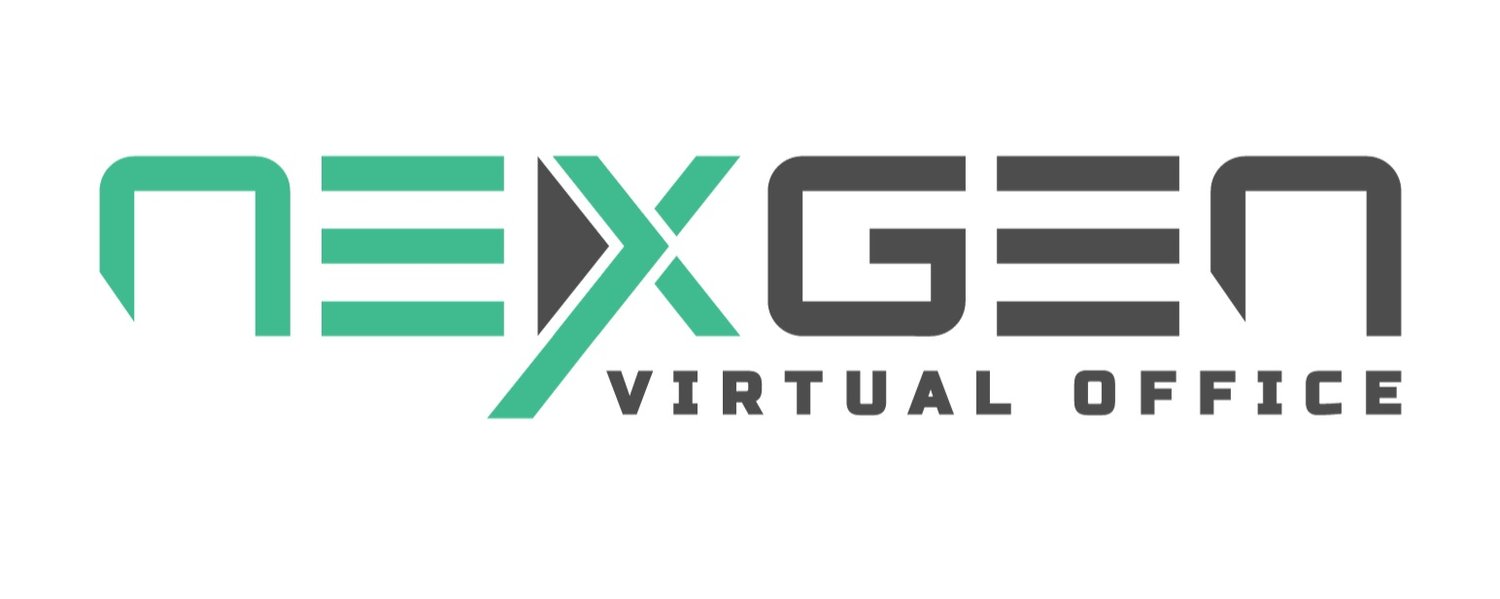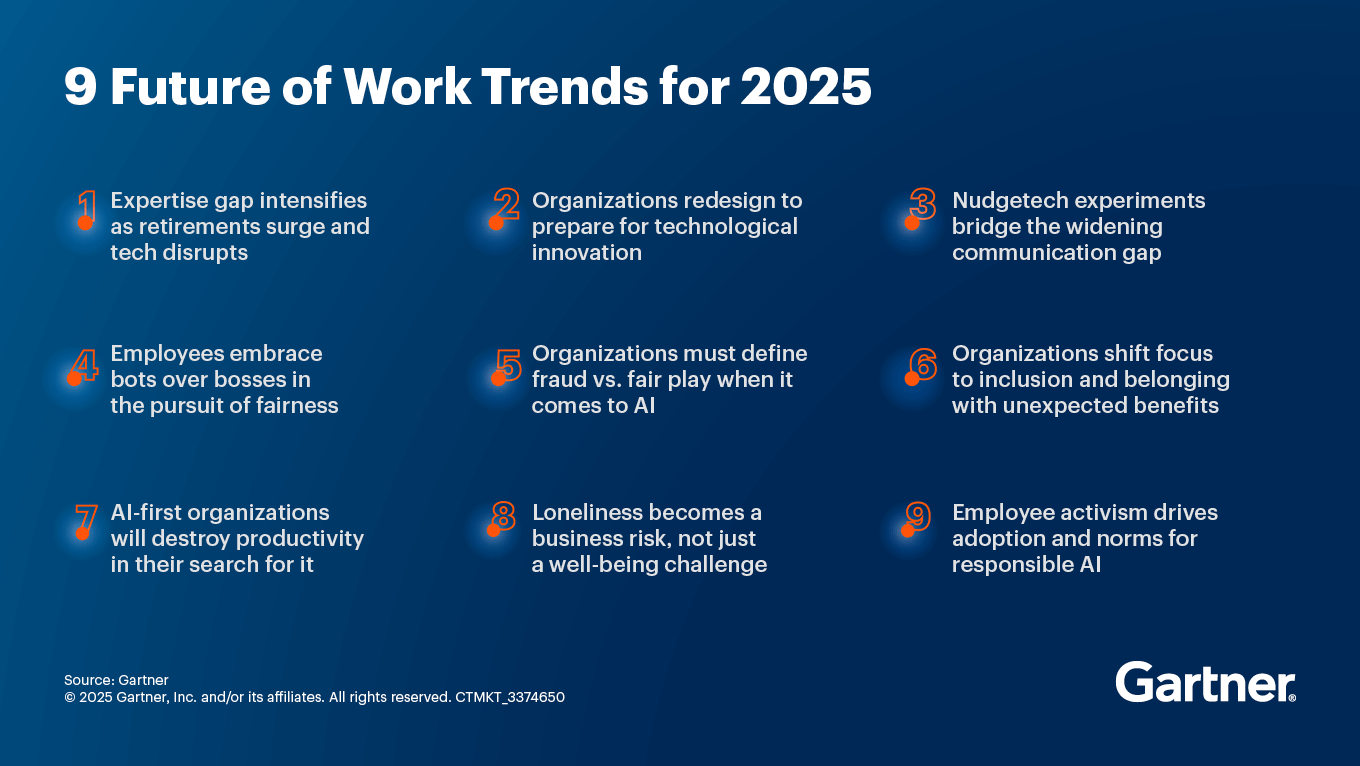9 Future of Work Trends for 2025
Harnessing AI, inclusion and innovation to drive organizational success and resilience.
By Emily Rose McRae | January 8, 2025 - As seen in Gartner
2025: A pivotal year for future of work trends
Rapid technological advancements and evolving workforce dynamics are set to redefine how organizations operate. Are you ready to navigate these transformative trends and seize new opportunities?
The future of work trends in 2025 will redefine how organizations operate amid rapid technological advancements and shifting workforce dynamics. This year’s trends emphasize the integration of AI, the importance of employee well-being, and the need for diversity and inclusion.
By embracing these trends, organizations have the opportunity to enhance productivity, foster innovation and build resilient, inclusive cultures that thrive in a competitive global landscape.
Future of work trends: Key insights for 2025
The landscape of work is rapidly changing, driven by technological advancements and shifting societal expectations. Here are nine key trends shaping the future of work.
Future of Work Trend 1: Expertise gap intensifies as retirements surge and tech disrupts
Organizations are facing an expertise supply crisis as a large portion of the workforce nears retirement. This trend is compounded by technological disruptions that reduce opportunities for novice employees to develop expertise.
Future of Work Trend 2: Organizations redesign to prepare for technological innovation
In 2025, many organizations will undergo transformative restructuring to enhance operations. This involves rethinking organizational structures to become more agile and responsive to the fast-paced technological landscape, aiming to unlock new levels of efficiency and innovation.
Future of Work Trend 3: Nudgetech experiments bridge the widening communication gap
Nudgetech, a set of AI-powered tools, is being used to bridge communication gaps in diverse workforces. By aligning communication styles across cultural and generational lines, these tools aim to enhance collaboration and cohesion in increasingly complex work environments.
Future of Work Trend 4: Employees embrace bots over bosses in the pursuit of fairness
The growing comfort with AI tools in performance management reflects a shift in employee attitudes, as many believe these tools offer a more unbiased approach to feedback and evaluation compared to traditional methods.
Future of Work Trend 5: Organizations must define fraud vs. fair play when it comes to AI
As AI becomes more integrated into productivity processes, organizations face the challenge of distinguishing between genuine skill and AI-enhanced output. This highlights the need for clear guidelines to maintain integrity and fairness in the workplace.
Future of Work Trend 6: Organizations shift focus to inclusion and belonging with unexpected benefits
Leading companies are embedding diversity, equity and inclusion (DEI) into their core strategies. By fostering an inclusive environment, they recognize that diverse teams drive better decision making and innovation.
Future of Work Trend 7: AI-first organizations will destroy productivity in their search for it
An AI-first approach can inadvertently increase work friction if not carefully managed. This underscores the importance of aligning AI initiatives with organizational goals to maximize their potential benefits.
Future of Work Trend 8: Loneliness becomes a business risk, not just a well-being challenge
Loneliness is emerging as a significant factor affecting employee performance and engagement. Recognizing it as a business risk, organizations are exploring ways to foster connections and support among employees.
Future of Work Trend 9: Employee activism drives adoption and norms for responsible AI
Employee activism is shaping the standards for responsible AI use in the workplace, highlighting the role employees will play in shaping the ethical and practical use of AI.
FAQ on future of work trends:
What are the key future of work trends for 2025?
The key future of work trends for 2025 include the integration of AI and automation; a focus on employee well-being and engagement; the importance of diversity, equity and inclusion (DEI); and the rise of gig work and alternative employment models. Organizations are also prioritizing the development of a future-ready workforce by addressing expertise gaps and leveraging employee activism to drive positive change. By understanding and adapting to these trends, businesses can position themselves for success in the rapidly evolving work landscape.
How can Chief Human Resources Officers (CHROs) leverage AI to enhance workforce performance?
CHROs can leverage AI to enhance workforce performance by integrating AI tools into performance management systems to provide unbiased assessments and support employee development. AI can help identify skills gaps, streamline operations and automate routine tasks, allowing employees to focus on more strategic activities. It’s crucial for CHROs to balance AI insights with human oversight to ensure comprehensive evaluations. Additionally, engaging employees in the development of AI policies can foster transparency and trust, aligning AI use with organizational values and enhancing overall workforce performance.
Why is fostering a culture of inclusion and diversity crucial for the future of work?
Fostering a culture of inclusion and diversity is crucial for the future of work because it drives innovation, enhances decision making and improves employee engagement. Diverse teams bring varied perspectives and experiences, leading to more creative solutions and better business outcomes. By integrating DEI into core strategies and training leaders to address biases, organizations can create an inclusive environment where all employees feel valued and empowered. This not only attracts top talent but also strengthens the organization’s ability to adapt to changing market dynamics, ensuring long-term success.

